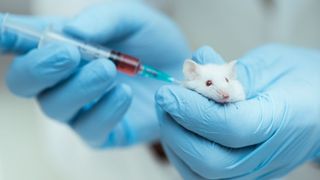The new vaccine ameliorated certain signs of aging in mice

An experimental vaccine successfully eliminated aging cells from the bodies of mice, helping to prolong the rodents’ lives and reverse some signs of age-related disease. The researchers say the experiment is a step on the road to a similar vaccine for humans, but could it really work?
“I think the data was extremely strong … I think it’s a really good proof-of-principle,” Paul Robbins, a professor of biochemistry, molecular biology and biophysics and an associate director of the Institute on the Biology of Aging and Metabolism at the University of Minnesota, said of the mouse study. In theory, the same approach would work in humans. But the big question is whether that vaccine would be safe in humans, Robbins, who was not involved in the research, told Live Science. To figure that out, the researchers would need to conduct additional studies in animals, including non-human primates, and thorough safety trials in human patients.
The new vaccine targets senescent cells, which are cells that have stopped multiplying due to damage or stress, but don’t die when they should, according to the National Institute on Aging (NIA). These cells accumulate as we age, as the immune system becomes less efficient at clearing such cells from the body. Senescent cells release compounds that trigger inflammation and thus damage nearby healthy cells. And evidence suggests that this buildup of senescent cells contributes to a slew of age-related diseases, including cancer, Alzheimer’s and atherosclerosis, a disease where plaque builds up in the arteries.
For the past decade, scientists have been working to develop “senolytic therapies,” or drugs that can clear senescent cells from the body. Some of these drugs have reduced inflammation, delayed the onset of age-related diseases and extended the life span of rodents. A couple dozen of these drugs have entered clinical trials in human patients, Robbins said.
The potential benefit of using a vaccine rather than drugs to target senescent cells is that people could be given the shot at, say, age 50 and avoid accruing senescent cells in the first place, Robbins said. A vaccinated person’s immune system would be trained to look for senescent cells and destroy them on sight; in contrast, someone taking senolytic drugs would need to take them repeatedly, as senescent cells would reaccumulate after each course of treatment, he said.
To develop their senolytic vaccine, the researchers selected a specific target, or “antigen,” on senescent cells — a sort of bullseye for the immune system to aim at. But because cells throughout the body can become senescent, different senescent cells look different than one another, senior author Dr. Tohru Minamino, a professor at Juntendo University Graduate School of Medicine and the director of cardiovascular medicine at Juntendo University Hospital in Tokyo, told Live Science in an email.
In this proof-of-concept study, the team zeroed in on just one cell type: senescent vascular endothelial cells, which line the insides of arteries, veins and capillaries. They analyzed which proteins appear in large quantities on the surfaces of these cells, to see which proteins would make a good target for their vaccine.
The fight to find anti-aging chemicals and products that can help reduce the conditions we suffer from in old age has been ongoing for years now. Beauty products that promise to reduce wrinkles and other age-based effects are common in supermarkets. While evidence has been found that we can’t reverse aging, scientists continue searching for more options.
To test the true effectiveness of PCC1, the researchers injected 171 mice that were at least two years old. They then continued to inject the mice with the substance, or a control solution, twice a week for the rest of the creature’s lives. The lifespan of the mice injected with PCC1 increased by around nine percent.
During the tests, the researchers also learned that PCC1 appears to completely disregard younger cells. Because it has no ill effect on the cells we still need, it could become a vital part of anti-aging therapeutic therapy. Of course, these tests are still just a single step forward in the journey. Scientists will now need to investigate whether PCC1 has similar effects on people, or if it only works on mice.
